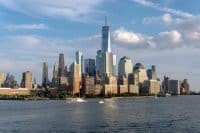
In its 2016 Best Global Brands report, consultancy Interbrand focuses on growth for companies, stockholders, stakeholders and, if done really well, humanity in general. That’s a tall order for a product, much less a brand.
Interbrand’s Paola Norambuena outlines four factors common to the best brands in this year’s survey:
A clear strategy for growth
Not all growth challenges are the same—whether an organization needs to scale before leaping forward, whether it needs to break a new barrier in order to expand, or whether it needs to reinvent in order to find new relevance, what Best Global Brands exhibit is the ability for deep and honest introspection—but they never get stuck there. It’s about having enough understanding to ensure meaningful change and speed of action.
The blurring of traditional sectors
As [clear definitions between traditional sectors] continue to blur, traditional measures and competitive comparisons change dramatically. And it becomes all the more critical that real measures come from a brand’s core—from its business and brand strategy.
Continue to borrow from the best
By aligning with complementary partners, as well as acquiring or embracing what others do exceptionally well, each organization can strengthen its core offering, extend its positioning, accelerate innovation, and create new experiences for customers. Selecting these partners or acquisitions takes great care, but the growth opportunity can be exponential.
Cohesiveness for customer-centricity
The leading and Top Growing Best Global Brands understand that branding is not an exercise in vanity, but a keen tool for business growth. That’s what yields beautifully connected and intuitive experiences for real people.
The companies posting the largest gains in brand value in the 2016 Interbrand study were Facebook, up 48% to a brand value of $32.6 billion, and Amazon, up 33% to a value of $50.4 billion. As a percentage of market cap, Facebook’s brand value is equal to 8.9% of its market cap, and Amazon’s brand value is equal to 12.7% of its market cap.
At the other end of the top 100 global brands are the companies that have lost brand value since the last Interbrand survey. Some, like IBM, Xerox and Gillette, have been on steady downward trajectories for the past three years. Others, like Shell, ran into economic headwinds, and still others, like Volkswagen, made huge mistakes that bludgeoned the brand.
The following list includes the 13 brands that lost the most brand value in 2016. We’ve include their percentage drop, the total brand value, and brand value’s percentage of market cap as of Wednesday morning.
- International Business Machines Corp. (NYSE: IBM): down 19%; brand value $52.5 billion; 34.9% of market cap. IBM dropped 8% of its brand value in 2014 and 10% more in 2015.
- Royal Dutch Shell PLC (NYSE: RDS-A): down 17%; $4.6 billion; 2.1%. The oil supermajor added 14% in 2014 and dropped 12% in 2015.
- Prada: down 12%; $5.5 billion; 67% of market cap. The fashion house added 7% in 2014 and added 4% in 2015.
- Xerox Corp. (NYSE: XRX): down 12%; $5.3 billion; 52.5% of market cap. The technology company dropped 2% in 2014 and dropped 9% in 2015.
- Ralph Lauren Corp. (NYSE: RL): down 12%; $4.1 billion; 49.4% of market cap. The apparel firm added 9% in 2014 and dropped 7% in 2015.
- Gillette: down 10%; $19.95 billion; n/a. The brand dropped 9% in 2014 and dropped 3% in 2015 (Procter & Gamble paid $57 billion for Gillette in 2006).
- HSBC Holdings PLC (NYSE: HSBC): down 10%; $10.5 billion; 7% of market cap. The big bank added 8% in 2014 and dropped 11% in 2015.
- Volkswagen: down 9%; down 9%; $11.4 billion; 16% of market cap. The German carmaker added 23% in 2014 and dropped 9% in 2015.
- Discovery Communications Inc. (NASDAQ: DISCA): down 9%; $5.9 billion; 39% of market cap. The entertainment company added 7% in 2014 and added 6% in 2015.
- Tiffany & Co. (NYSE: TIF): down 9%; $5.76; 63.8% of market cap. The luxury jeweler added 9% in 2014 and added 6% in 2015.
- Caterpillar Inc. (NYSE: CAT): down 9%; $5.45 billion; 10.5% of market cap. The heavy equipment maker dropped 4% in 2014 and dropped 12% in 2015.
- Burberry: down 9%; $5.36 billion; 66% of market cap. The fashion apparel company added 8% in 2014 and added 5% in 2015.
- MTV: down 9%; $4.32 billion; n/a. The entertainment company (owned by Viacom) added 2% in 2014 and dropped 7% in 2015.
Take Charge of Your Retirement In Just A Few Minutes (Sponsor)
Retirement planning doesn’t have to feel overwhelming. The key is finding expert guidance—and SmartAsset’s simple quiz makes it easier than ever for you to connect with a vetted financial advisor.
Here’s how it works:
- Answer a Few Simple Questions. Tell us a bit about your goals and preferences—it only takes a few minutes!
- Get Matched with Vetted Advisors Our smart tool matches you with up to three pre-screened, vetted advisors who serve your area and are held to a fiduciary standard to act in your best interests. Click here to begin
- Choose Your Fit Review their profiles, schedule an introductory call (or meet in person), and select the advisor who feel is right for you.
Why wait? Start building the retirement you’ve always dreamed of. Click here to get started today!
Thank you for reading! Have some feedback for us?
Contact the 24/7 Wall St. editorial team.

